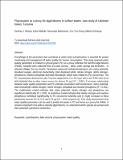| dc.description.abstract | Knowledge of the parameters that contribute to water body eutrophication is essential for proper monitoring and management of water quality for human consumption. This study assessed water quality parameters in relation to phycocyanin (PC) as a proxy indicator for harmful algal blooms (HABs). Samples were collected from 23 water sources – lakes, wells, springs and boreholes – in selected villages, for six months. Parameters measured included temperature, pH, redox potential, dissolved oxygen, electrical conductivity, total dissolved solids, nitrate nitrogen, nitrite nitrogen, phosphorus, reactive phosphate and total chlorophyll, which were related to (PC) occurrence. The PC concentration detected in Lake Victoria ranged from 5 to 58.4 μg/l above the WHO alert level and exceeded that in other water sources by almost 30 μg/l (P < 0.001). Univariate relationship between water quality parameters and PC indicates association with temperature, redox potential, total chlorophyll, nitrate nitrogen, nitrite nitrogen, phosphate and reactive phosphorus (P < 0.001). The multivariate model indicates that redox potential, nitrate nitrogen and phosphorus are significant statistically (P < 0.05). A predictive model indicates that nitrate nitrogen and reactive phosphorus contribute significantly to PC occurrence whereby unit (1 mg/l) increases in these parameters increase PC by 9.55 and 4.38 μg/l (P < 0.05) respectively. This study demonstrates that water quality parameters can be used to predict increases in PC and hence as a proxy for HABs. It remains important to be able to classify algal blooms, to understand which species are present and their potential cyanotoxin production. | en_US |

